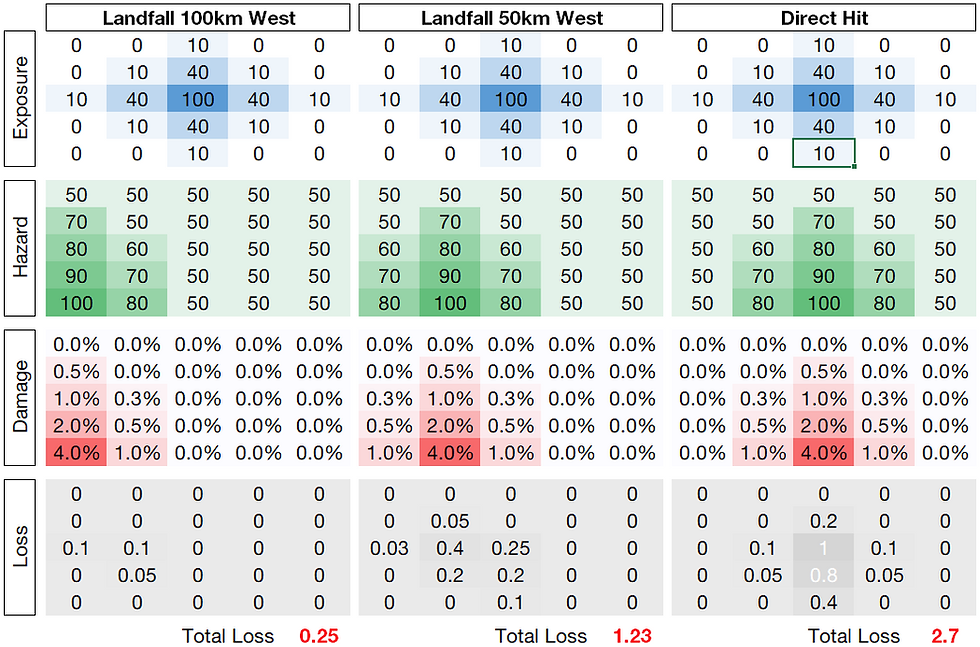Five thoughts on Hurricane Matthew
- Richard Dixon

- Nov 1, 2016
- 3 min read
Given the number of years since a major hurricane landfall, naturally Hurricane Matthew drew a lot of attention. I'll leave the meteorological autopsy of the event to the many excellent summaries from catastrophe modelling companies, brokers and re/insurers that have appeared and offer up five observations that struck me during and after the event.
Loss data for cat model improvements: "same old same old"? The swathe of winds across coastal eastern Florida and into Georgia and the Carolinas was largely in the range 70-90 mph. As with any cat event, this brings the potential of more loss data hopefully to help tighten up the huge uncertainty that exists around vulnerability curves. However the story, at least from the wind perspective, has been the same across Sandy, Irene, Hermine and Matthew in recent years: the winds are helping us understand the vulnerability better across the lower end of the curve. We still don't have very much loss data for winds above around 110-120 mph, my concerns around which I will address in a forthcoming blog post.

Wind and Flood correlation One question I have asked of vendors presenting flood models in the last couple of years is whether their flood offering is directly fed by/connected to their hurricane model. Matthew's devastation of Haiti, followed by Bahamas, Florida and south-east coastal damage was followed by the noteworthy rainfall totals and flooding in the Carolinas. I hope the example of Matthew will add more impetus into ensuring inland flood modelling goes hand-in-hand with hurricane modelling as a standard requirement, especially given more and more re/insurers are now looking to expand into offering inland flooding products.

Matthew's Coastal "flirting"
One of the more remarkable elements of Matthew was how it flirted with the eastern seaboard of central and northern Florida before finally making landfall.further north in the Carolinas. Was the motion of the storm fortuitous in keeping the eye just offshore, or is there anything in the interaction between the hurricane and landfall that physically led the hurricane to skirt the coast?
The simple schematic here shows the backing of the winds through frictional interaction with the coastline in a hurricane as it grazes along the coastline. Do those "backed" winds in orange act in any way to bodily change course of the hurricane by keeping it out to sea? You can see how the turning of the wind with increased friction points off the coast. This is mere conjecture on my part here. I'd love to see a numerical model re-run of Matthew with coastal friction tuned off just to see if this has any impact on the path of the storm.
The hurricane drought continues It's a fortuitous spell of activity that has kept the "big hit" away from the insurance industry, but since 2005 we've had Hurricane Ike in 2008 all of 6 hours away from being a Cat 3 landfall, Matthew was all of about 25 miles away from a Cat 3 landfall and the chart below [highlighting the tracks of Atlantic tropical systems at hurricane strength since 2006] demonstrates how many hurricanes have been there or thereabouts and just how fortuitous the spell has been for Florida.
A lot is made of the ongoing drought, but until we find a mechanism or step change in what is driving our hurricane seasons that helps our understanding, it's still just good old capricious Lady Luck and nothing more - a conclusion drawn by the interesting paper by Hall and Hereid (2015).
Twitter coverage a boon (with the odd bust)
When the last major hurricane made landfall in 2005, Twitter didn't exist. Commentary on Twitter from many on Matthew was superb, if you know who to follow. It's testament to the amount of information out there during an event that I very rarely looked to the NHC website for information on how the storm was proceeding: this is not in any way however to downplay the NHC's vital importance to the public and government alike in (potentially) landfalling hurricane events.
Special mention from my Twitter feed should go to Eric Blake of the NHC (@EricBlake12) and Ryan Maue (@RyanMaue) from WeatherBELL who were both insightful without being sensational. On which note, there was one article that appeared during Matthew's near-landfall that suggested, through some rather poor wording, a $200bn storm surge was possible from Matthew, which was irresponsible more than anything. Fortunately, if you're selective, there's a lot more good than bad in using Twitter pre-, during and post-events.




Comments